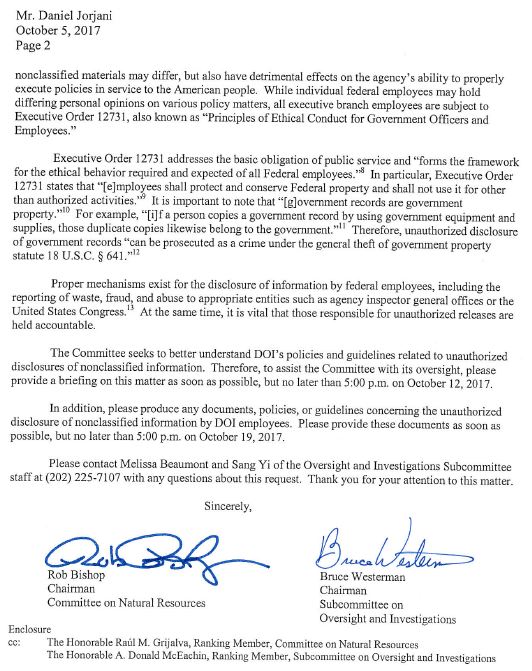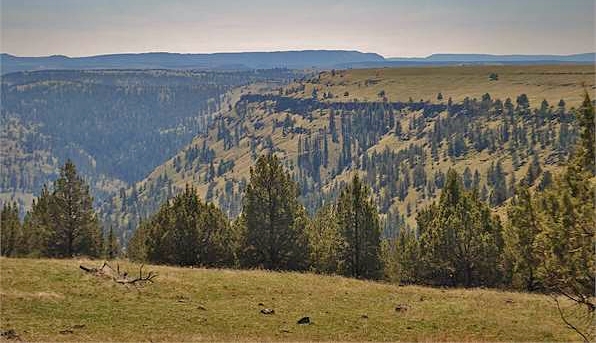In possible reference to published articles containing images (copied, cell phone pictures) of leaked Interior Department memos and docs, the letter reiterates the criminal nature of the sort of leaks which seem to be commonplace in the agency.
by Marjorie Haun
On October 5th, Rob Bishop, Chairman of the House Committee on Natural Resources along with Bruce Westerman of the Oversight and Investigation Committee, issued a pointed letter to Daniel Jorjani, Principal Deputy Solicitor for the Department of Interior (DOI), citing ‘at least four instances’ in which sensitive internal documents have been leaked to media. In the letter’s closing, Bishop and Westerman demand that Jorjani produce evidence related to the leaks and the leakers no later than October 19.
The specific articles mentioned in the letter, apparently from leakers within Interior, include Matthew Daly’s piece about the potential modification of 6 national monuments; Ken Silverstein’s article about Arctic drilling assessments; Stuart Leavenworth’s piece about Trump’s reworking of hunting regulations; and the recent New York Times article about BLM plans to review Western sage grouse-related mining moratoriums. All the articles cite or publish actual leaked documents from Interior, which contain markings and computer notations showing that they are in the draft stage and still undergoing changes. All of the leaks were in violation of Interior Department rules, and appear to have been done to inflame controversy over issues such as Secretary Zinke’s review of national monuments, and the possible reversal of Obama-era mining moratoriums. The Bishop/Westerman letter states:
Over the past two months alone, the media reported on information based on at least four instances of improper disclosure of internal Department of the Interior (DOI) documents. These documents include memoranda from: Secretary Zinke for the President related to the Antiquities Act; Acting Fish and Wildlife Service Director James Kurth related to geological and geophysical exploration regulations; Acting National Park Service Director Michael Reynolds related to the Sportsmen’s Heritage and Recreation Enhancement (SHARE) Act; and a draft notice of intent concerning Bureau of Land Management sage grouse habitat management plans.
Specifically, the unauthorized disclosed versions of these documents are apparently internal working documents, and are accompanied by edits or notations highlighting their nature. For example, the memorandum related to the Antiquities Act is clearly marked as “Draft Deliberative – Not for Distribution.” The memoranda from acting directors Kurth and Reynolds have editing markings by computer and hand, respectively, also indicating the draft nature of these documents.
The letter makes clear that not only is the act of leaking internal documentation improper, it can carry with it federal penalties, including imprisonment. Bishop/Westerman further detail how such leaks can prove detrimental not just to the public image of the agency, but to the department’s policy initiatives. The letter also notes that ‘Release of such documents could…result in improper financial advantage for unauthorized recipients of information.’
Acknowledging that ‘individual federal employees may hold differing personal opinions’ on the direction of the Interior Department, the letter reiterates that ‘all executive branch employees are subject to Executive Order 12731, also known as “Principles of Ethical Conduct for Government Officers and Employees.’
In possible reference to published articles containing images (copied, cell phone pictures) of leaked Interior Department memos and docs, the letter drives home the criminal nature of the sort of leaks which seem to be commonplace in the agency.
For example, “[i]f a person copies a government record by using government equipment and supplies, those duplicate copies likewise belong to the government.” Therefore, unauthorized disclosure of government records “can be prosecuted as a crime under the general theft of government property statute 18 U.S.C. § 641.”
Bishop and Westerman have requested a briefing by the Deputy Solicitor on DOI “policies and guidelines related to unauthorized disclosures of nonclassified information” by October 12, as well as “documents, policies, or guidelines concerning the unauthorized disclosure of nonclassified information by DOI employees” by the 19th.
Whether the Interior Department leaks are part of ‘Deep State’ operations is difficult to say, but with numerous Executive Branch appointments held up by Senate inaction, there are doubtless many holdovers in the department from the previous administration, whose land management philosophy went radically askew from the actual missions of agencies such as the Bureau of Land Management, Fish and Wildlife, and others.
The leaks have been exploited by several radical groups–some mentioned in the articles cited above–to whom Obama and his Interior Department were sympathetic and accommodating, so policy reversals, and Trump’s emphasis on resource development and rural job creation appear to have ignited a type of activist dissent in some bureaucratic circles. This makes the possibility that the leaks are coming from a federal employee(s) opposed to Trump-ear changes quite high. Despite the emergence of internal rebellions, and noisy groups of ex-federal employees waging a social media war against Secretary Zinke and his vision for the agencies under his direction, there is a new momentum within the Interior Department. Beyond the echo chambers of urban mainstream media outlets’ and extreme green groups’ incessant grumbling, the development of natural resources to create jobs and free up the potential of locked-up public lands, is resonating very well in the rest of America.
See the full letter below


[paypal_donation_button]
Free Range Report
[wp_ad_camp_3]
[wp_ad_camp_2]



